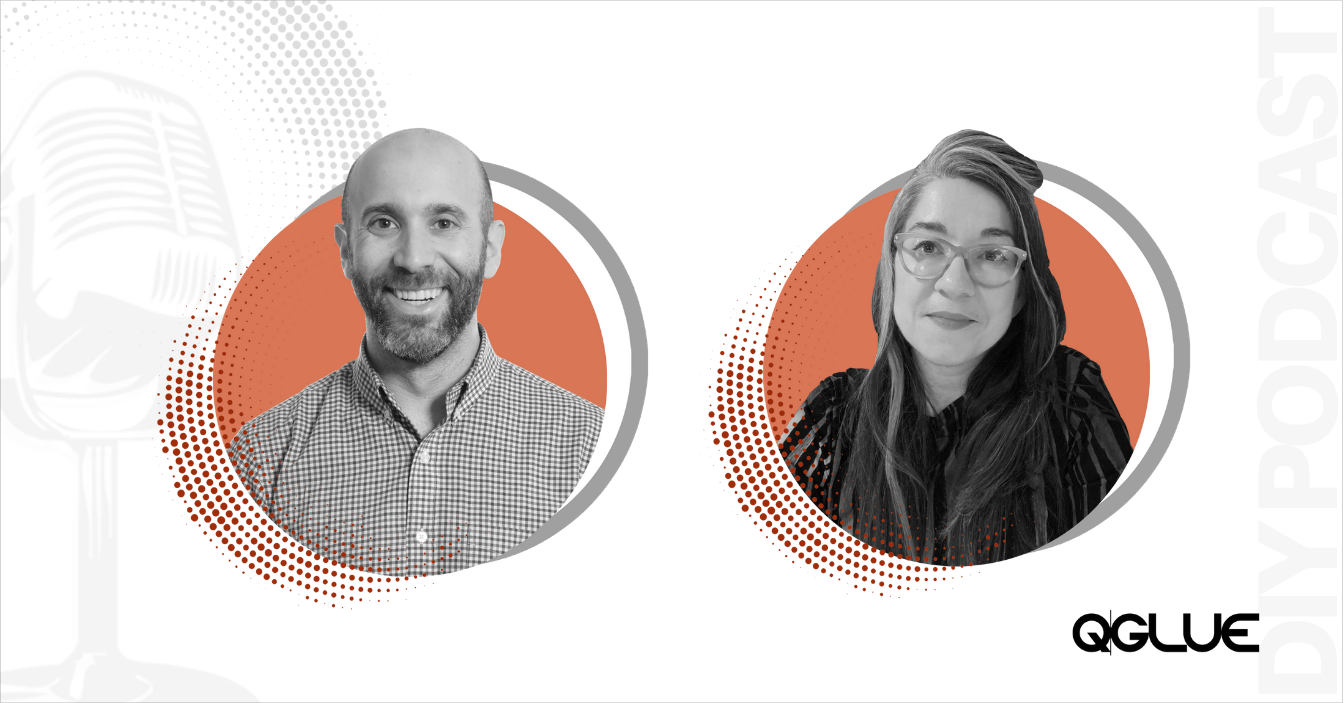DIY PODCAST
Design, Innovation & You
“Going slow to go fast.”
Navigating the world of design thinking can be a daunting task— a few questions you may find yourself asking: “How do I determine meaningful KPIs?”, “Should I invest in a design sprint/hackathon?” “How can I apply design thinking in a large enterprise?” Well, Eric and Hadassah have spent a majority of their lives mastering the answers to exactly these questions and we can’t wait for you to hear their insights and experiences!
Welcome to Design Innovation, and you, a podcast for innovators, entrepreneurs, and design enthusiasts looking to create a better tomorrow. I’m your host, Lavanya Anaja, and with this initiative by Qgloo, navigating the world of design thinking can be daunting. You may ask yourself a few questions: How do I determine meaningful KPIs? Should I invest in a design sprint or a hackathon? How can I apply design thinking in a large enterprise? Eric Moro and Hadassotamian have spent most of their lives figuring out the answers to those questions. They’re here with us today to share their insights and experiences.
Thank you.
Yeah, it’s great to be here.
How did you get introduced to the world of design thinking and innovation?
I got introduced to the world of innovation by working with cities to do some innovation work around budgeting and participation in democracy. And from there, I started learning and exploring different human-centred and participatory design methods. And from that, I got introduced to design thinking methods. And I love the authentic engagement of using these methods and how they are applied. Like, we can apply creativity to real-world problems.
Eric, that’s amazing.
Yeah. My introduction came from teaching Lean start-up methods to large enterprises with General Assembly. And one of my co-facilitators was a woman named Jennifer Lopez, who worked at Capital One at the beginning of their Design Thinking program. And so I came in there to help with their design thinking training and quickly learned that Design Thinking and Lean Startup have many similarities. I started learning about design thinking at Capital One and eventually joined the Design Thinking program at IBM. Wow.
Amazing. Amazing backgrounds there. The Design Thinking helps address because I feel that’s a question many people ask, like, why design thinking?
I think that’s an excellent question. And heat on the street about design thinking if we could solve every problem with it. But what I liked about design Thinking is something that my colleague also Surface strategy Naveen Raja says, which is design Thinking is about issue speaking over problem-solving. So really, to me, design Thinking building off this idea is a way to pause and examine the problem spaces you’re getting into to understand if it’s a problem that needs solving, what part of it needs solving, and is it feasible to solve it, who wants it solved, in what way? And so it is a bit general and application, but to me, it’s about digging into the problem space to see if you should be spending time and resources on solving the problem and for whom and in what way.
That’s amazing. Eric, I love your interest.
I think design thinking is a tool for solving challenging problems that don’t have obvious answers. And in the enterprise space, we have many examples of those where the enterprise tries to decide where we should invest resources? Which customer voice are we going to listen to? And I think of those as strategic initiatives. And design thinking is compelling at helping companies take those first few steps when they’re saying, okay, what should we be doing around this entire problem space rather than a particular type of thing. So when the question is really like, why should we do this? Or how should we do this? Design thinking excels.
That’s great to hear. I think that’s an excellent way to set up the foundation for this episode. So actually, that brings me to my next question. Aries, you have a massively popular article on medium titled Six Types of Design Thinking. And we also talked about that in our last call with Mavic. So how does that build your foundation for your approach to design thinking and walk us through it a little bit?
Of course.
So this is a concept I learned from another of our colleagues, Ryan Hoffman, that designing workshops are comprehensive. And so, instead of calling something a design thinking workshop, I usually ask people, what are you trying to accomplish? And through my experience, I’ve learned that people are trying to achieve one of a relatively small number of things. A prominent example is that I want to co-create something with my users. I don’t want to sit in a room with my colleagues. I want to bring our customers or end users into the process. So then we can have a co-creation workshop, or we’re looking for new ideas to focus on. We’re trying to explore some new problem areas we haven’t approached that might be an innovation-type workshop. And of the six different types of workshops, let’s call the workshop what we’re trying to do. Right. Another popular workshop is its user story mapping. And teams always have trouble trying to move from concept to code. So they have an excellent idea. They know they vetted it with their customers, and now they want to start developing for it, and things get lost in translation.
So the underlying premise of the article is to call your workshop what it is you’re trying to do and don’t just call everything a Design Thinking workshop.
Right. I think that’s a perfect thing to keep in mind always.
That’s great.
You were talking earlier about enterprise Design thinking, and the question I have for you would be, what is enterprise design thinking and basically, what differentiates it from just run-of-the-mill design sprints or design thinking in general?
I think that’s a great question. And like all good practices, it’s an awareness of the context in which you apply this practice. So Enterprise Design thinking is ensuring that the way that we work together integrates and works well with the ways that enterprises work, from hierarchies to decision making to the potentially long tails of work. Some goals are to shorten work timelines, reveal and make it easier for people to make decisions, and work cross-functionally and across hierarchies. But enterprise design thinking means that we understand what it’s like to work in large organizations, with large organizations, with the types of problems, challenges, and opportunities they have.
I think that’s right. I believe Design Sprints are a tool in the broader enterprise design thinking toolkit. And they’re perfect for specific applications, very good for kicking off a project and wanting to move fast. But I think that over the long haul, over a three to five to a seven-year cycle of working with customers and transforming your business, a Design Sprint is a powerful tool to introduce people to design thinking methodologies. Still, ultimately it will not get you all the way there. It needs to be partnered with other methods, like research operations.
Yes, that’s a perfect segue because I know you spoke about going slow to go fast.
So could you tell us a little?
The bit about how it applies to your approach towards enterprise design thinking? Absolutely.
I love this concept. Going slow to go fast pushes back against a natural tendency to start solving problems right away, like we’ve noticed something, fix it, fix it, fix it. And that approach, while it generates solutions, doesn’t necessarily develop the best solutions, get to the most profound problem, or get those solutions going the best way. So while we love ideas, there are lots of ideas out there. To me, going slow is how you can stop, slow down, and say, hey, how do we know this idea will solve this particular problem? How do we know that this part of the problem is the one we’re trying to solve? Is it an interaction issue? Is it an education issue? Is it a platform issue? What is the actual problem under the problem? And when we pause and go slow and ask these questions, we often find that we’re not necessarily going to solve it the way we first thought we were going to. And that’s great, that saves time, that saves resources, that saves struggle and tribulation, but it does.
And none of us has time to waste time. Right? So this idea of going slow at the beginning, while it feels unnatural, I’ve genuinely watched it enabled teams to go much, much faster once it comes time to implement because they’re implementing something that they have. Validation is what’s needed and wanted.
Yeah, that’s great to hear. I love learning more about enterprise design thinking here. So I know, Eric, you have extensive experience working with IBM as a design facilitator. So I’d love to hear what IBM’s approach to implementing design thinking at scale is?
The IBM design system writ large under Phil Gilbert and Jimmy was spectacular and changed how I think enterprises can approach design and design thinking. But let me tell you more specifically my part. So when I first joined IBM M, I joined the Hybrid Cloud team and could see where the rubber hit the road. So what’s it like when design thinking is being introduced into an already existing team, and we’ve.
Copyright All Rights Reserved © 2018







